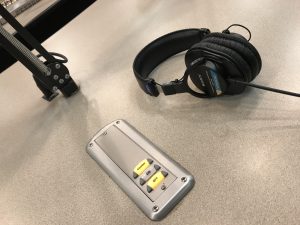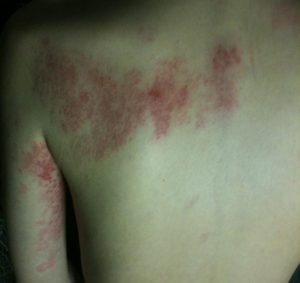 Since you asked . . . here’s another “Quick tips” post from last week’s Healthy Matters broadcast. I have included links to point you toward reliable information if you want to learn more. The Internet is full of not-so-reliable information so I try to include sources that I think you can trust. That’s assuming you trust me. As my texting daughter would say “hahahaha”!
Since you asked . . . here’s another “Quick tips” post from last week’s Healthy Matters broadcast. I have included links to point you toward reliable information if you want to learn more. The Internet is full of not-so-reliable information so I try to include sources that I think you can trust. That’s assuming you trust me. As my texting daughter would say “hahahaha”!
To listen to the podcast of this recent “Open Lines” show, click this banner and look for April 29, 2018 show (Healthy Matters show #485)
On to the questions from listeners . . .
It seems shingles is on everybody’s mind
Q: What age can you start taking the new shingles vaccine? (This was one of numerous questions about the shingles vaccine from listeners).
The new shingles vaccine (trade name is Shingrix) is worth getting. It is a two-part vaccine which is over 90% effective at preventing shingles (aka herpes zoster) and the awful post-herpetic neuralgia that sometimes follows it. Get the two shots two to six months apart. The recommended age to get it is over age 50. You should get the new vaccine even if you already received the older Zostavax shot, which was good but not nearly as effective. You should also get it even if you had shingles in the past or if you can’t remember if you had chicken pox.
One important point – if you get shingles near the eye you need to see an eye doctor. It can lead to herpes ophthalmicus which is a threat to your vision.
Lots more about shingles from the CDC here.
Is it dementia or depression?
Q: Is there a test to discern the difference between dementia and depression symptoms in an elderly woman?
This is a common question for good reason. The symptoms of dementia and depression can overlap a great deal, even though these are two entirely different conditions. Not only that, often people have both conditions simultaneously.
Dementia is a cognitive disorder that is slowly progressive over time. Major features are memory loss, confusion, and lack of ability to perform daily functions.
Depression is a mood disorder that has periods of worsening symptoms mixed with periods of relatively normal mood. Major features are feeling sad, hopeless, apathetic.
Older adults can have features of both of these conditions. But they are treated very differently so I strongly suggest seeing a health professional to sort things out. I particularly recommend seeing a specialist in older adults – a geriatrician – if you can. Here are some good geriatricians in Minneapolis. Insider tip: one of them – Dr. Abigail Houts – even does house calls.
Keep in mind neither dementia nor depression are normal parts of aging. There are resources and treatments. Here are some good sites I found:
- Here is a page comparing depression and dementia from a consortium in Canada.
- The Alzheimer’s Association has a wealth of info.
- I send people to the National Alliance on Mental Illness all the time for supportive and trustworthy mental health information.
Medications for blood pressure
Q: Spouse on two blood pressure medications – HCTZ and lisinopril – blood pressure remains high. What to try next?
You all love to take more and more medications, right?
High blood pressure is one of those conditions that is a) really harmful to your long-term health, b) usually without symptoms, and c) treatable. The deal is, however, that most people will not get adequate control of their blood pressure with a single medication. This is because hypertension tends to get worse as we age. Even if one medication kept your blood pressure under control initially, it will probably be inadequate as your blood vessels age. Think of your blood vessels as nice garden hoses when you are young. Soft and expandable. Those garden hoses turn more into pipes as we age. So we need to add medications.
We’re trying to reduce the risk of three things: heart disease, stroke, and kidney disease. High blood pressure is bad for all three.
Blood pressure medications are divided into classes. Each class works in a different way. That’s why we usually add a medication from a different class rather than replace the medication you currently take.
Here are the currently recommended classes of medications for hypertension. First-line means that they should be used first since they are the most proven to work. Second-line alternatives are acceptable once the first-line have been used. I’m going to use some medical-jargon terms in this section because I think it is informative and gives you a flavor of the suffering medical students go through in their pharmacology course.
First-line blood pressure medications
Angiotension converting enzyme inhibitors (ACE-inhibitors). These end in the suffix -pril. The question above references lisinopril so that one is a keeper. ACE-inhibitors work in the kidneys to slow down the body’s renin-angiotensin-aldosterone system (RAA system).
An alternative to ACE-inhibitors is an aldosterone-receptor blocker (or “ARB”). These block that same RAA system but in a different way. Usually you don’t take both an ACE-inhibitor AND and ARB. You take one or the other. ARBs usually end in the suffix -sartan.
Thiazide diuretics. Also known as “water pills.” These medications work in the kidneys to cause a natriuresis – that is, they dump sodium (salt) into the urine. And as I endlessly hammer home to medical students: where salt goes, the water follows. (Conversely, this is why you should limit your sodium intake if you have high blood pressure. Too much sodium in your body has the opposite effect of diuretics). The two main diuretics for blood pressure are hydrochlorothiazide (HCTZ) and chlorthalidone, so the questioner above should keep on with the HCTZ.
Calcium-channel blockers. There are sub-types of CCBs but the ones usually used for blood pressure work by blocking the effect of calcium in the blood vessels. This causes the vessels to relax. They usually end in the suffix –pine and include medications like nifedipine, felopidine, and amlodipine. Probably this is the next one to add for the question above.
Second-line blood pressure medications
I’ll just list these without much comment. These are good medications, and there are times when they are actually the preferred first-choice (such as beta-blockers if you have heart failure). But for garden-variety hypertension, they are the second-line of defense.
Beta-blockers. Usually end in the suffix -lol.
Alpha-antagonists. They relax the blood vessels by blocker something called alpha receptors Examples are doxazosin, terazosin, and prazosin.
Alpha-agonists. Clonidine is the major one here. It works centrally (in the brain) by stimulating alpha-receptors which is confusing since the previous class of drugs blocks the alpha receptors. This is why medical school is so long.
Vasodilators. These directly cause blood vessels to relax. Two common ones are minoxidil and hydralazine.
Aldosterone antagonists. These block the action of aldosterone, a hormone that leads to salt and water retention. The main one is spironolactone, often replaced by eplerenone if the side effects are intolerable. Men start getting breast tenderness, for instance. I’m not kidding.
There are lots of others but these are the big ones and half of you are nodding off already with this question.
Here’s the take-home point: blood pressure medications all work in a different way. Because of that, they complement each other. They don’t replace each other. Go ahead, take your medications.
See my previous posts about high blood pressure at these links:
- Quick tips: tremors, high blood pressure, constipation
- New blood pressure guidelines: 130 is the new 140 Caveat – this post talks about the latest blood pressure guidelines, but in the post I don’t think I was clear enough that not all doctors – me included – really think we should be promoting these new guidelines too vigorously. The guidelines make sense for some people but probably not everybody.
- Pearls from Medicine Science: High blood pressure. An older primer I wrote on the basics and why you should care about high blood pressure.
If all that isn’t enough information for you on high blood pressure, go to the mother lode at the American Heart Association here.
There you go, three topics from the Healthy Matters mailbag. I hope you learned something.
If you have not subscribed by e-mail and you like what you see here, please subscribe by e-mail below. It helps me to know what people are finding useful.
Thanks!
David



